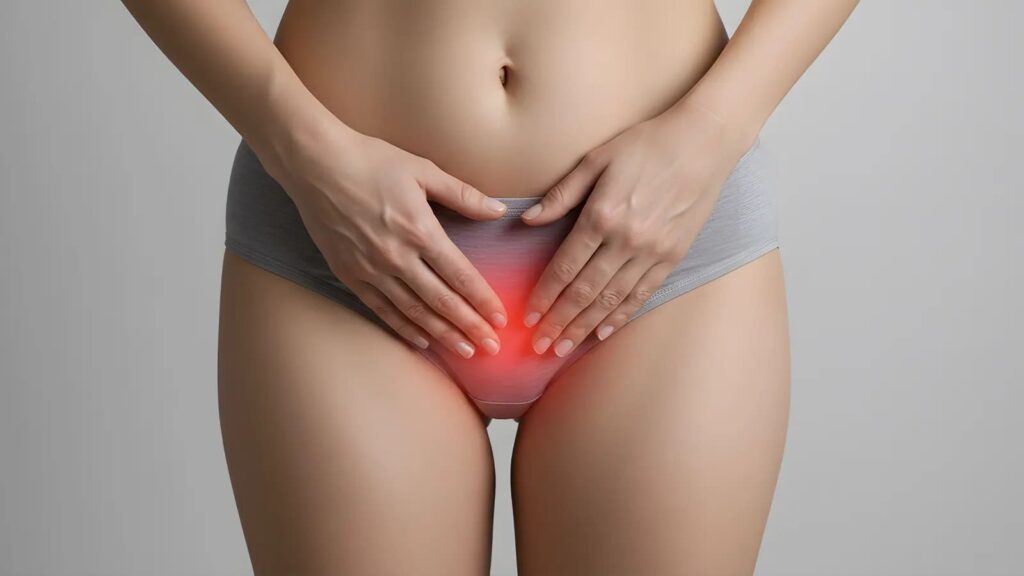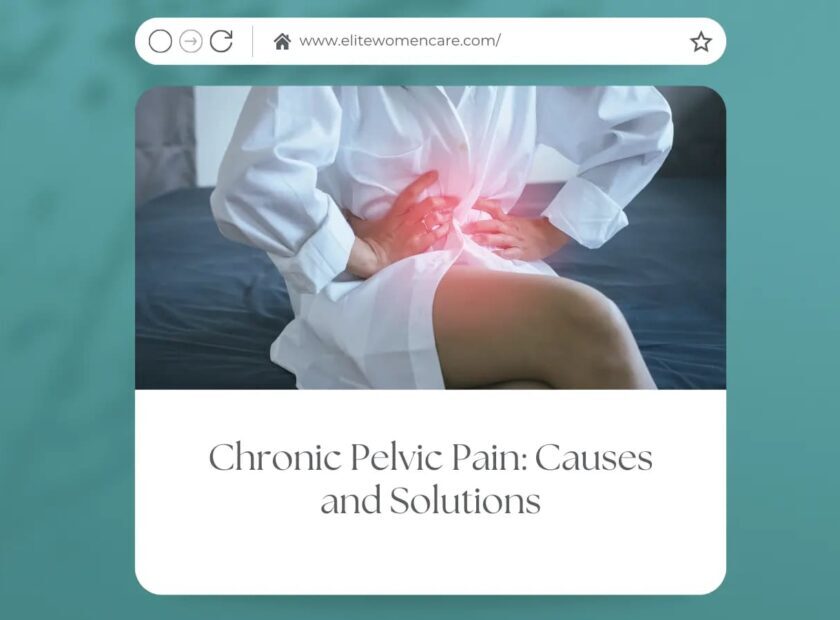
Chronic Pelvic Pain: Causes and Solutions
Chronic pelvic pain has one thing going for it- it very often turns incapacitating. It impacts millions worldwide.It pertains to any type of persistent discomfort located in the lower abdomen or pelvic region that lasts for more than six months. While acute pain often serves as a warning sign of an underlying injury or illness requiring urgent attention, the long term nature and wide range of potential causes of this condition can significantly impact a person’s quality of life. Those experiencing ongoing pelvic discomfort—or their caregivers—should gain a thorough understanding of the potential causes and available treatments.

This article dives deep into the multifaceted nature of chronic pelvic pain, exploring its common causes, how it differs in various populations, especially in chronic pelvic pain women, and the latest treatment approaches, including options for chronic pelvic pain syndrome treatment. It also highlights both medical and holistic approaches that can offer symptom relief, aiming to serve as a comprehensive guide to managing this life altering condition.
Understanding Persistent Pelvic Discomfort and Its Impact
This condition involves pain felt in the pelvic region lasting for more than six months. Sometimes, the sensation is a dull ache or burning feeling, while other times it manifests as sharp discomfort in the lower abdominal area. Regardless of the type, it greatly interferes with daily life. For many individuals, this discomfort extends beyond the physical aspect, affecting emotional and psychological well being and potentially causing anxiety, depression, and social isolation.
The perplexing nature of chronic pelvic pain syndrome is due to its vast spectrum of possible etiologies. It can be the result of gynecological, urologic, gastrointestinal, musculoskeletal, or perhaps even neuropathic etiologies. Diagnosis, because of such diversities, requires often a genuinely multidisciplinary setting, involving gynecologists, urologists, gastroenterologists, pain specialists, and physical therapists. The symptoms tend to overlap; hence pinpointing the condition means doing a thorough history assessment of the patient followed by meticulous examinations.
Common Causes of Chronic Pelvic Pain
Various causes of persistent pelvic discomfort can occur, depending on gender, associated medical history, and many other factors. For women, such symptoms may arise from endometriosis, PID, ovarian cysts, fibroids, or consequences of an operation such as adhesions. These conditions primarily cause inflammation, scarring, or nerve irritation, provoking constant pain.
In males, similar issues may result from chronic prostatitis or dysfunction of the pelvic floor muscles—both of which are rarely discussed in this context. Non gynecological conditions such as IBS, interstitial cystitis, hernias, and nerve entrapment syndromes are other possible contributors. Identifying the root cause accurately is crucial, as treatment approaches vary based on the underlying condition.
Pelvic Discomfort in Women: Unique Challenges and Considerations

When discussing chronic pelvic pain women experience, it is important to highlight some unique aspects that influence diagnosis and treatment. This issue tends to be more prevalent among women due to gynecological conditions such as endometriosis, which affects nearly 10% of women of reproductive age worldwide. Endometriosis occurs when tissue similar to the uterine lining grows outside the uterus, leading to inflammation and significant pain.
Treatment becomes more complicated as symptoms often fluctuate in response to hormonal changes throughout the menstrual cycle. Psychological factors such as stress or a history of trauma may also heighten the perception of pain. Given its complex and multidimensional nature, effective care requires a personalized approach, often involving a combination of medical, physical, and psychological therapies to provide meaningful relief.
Diagnostic Approaches for Pelvic Pain Syndrome
Accurate diagnosis of pelvic pain syndrome is essential for effective treatment. It can be challenging to diagnose due to overlapping symptoms with other medical conditions. The diagnostic process typically begins with a thorough medical history and physical examination, which may include a pelvic exam for women and a prostate exam for men. Imaging techniques such as ultrasound, MRI, or CT scans can assist in detecting structural issues like cysts or fibroids.
In certain cases, laparoscopy may be used to visually examine pelvic organs, particularly when endometriosis is suspected. Blood and urine tests can help rule out infections or inflammatory diseases. When the discomfort appears to stem from musculoskeletal or neuromusculoskeletal sources, assessment of the pelvic floor muscles and nerve conduction studies may be warranted. This comprehensive approach allows healthcare providers to evaluate all possible underlying causes and tailor treatment accordingly.
Chronic Pelvic Pain Syndrome Treatment Options
Generally, a series of treatment modalities have been suggested for chronic pelvic pain syndrome on a case to case basis and to fit pain severity. Physical therapy is one conservative treatment option that has been very successful for many in relaxing and strengthening the pelvic floor muscles. Pelvic floor therapists can teach patients in techniques to relax their muscles, which in many episodes may be the main source of pain. Pain management may differ according to the cause and also consist of NSAIDs, hormonal medicines, antidepressants, and antineuralgics. A diagnosis of endometriosis may require suppression or surgical removal of endometrial tissue. Nerve involvement might also be treated with interventional pain management treatments like nerve blocks or trigger point injections. All attempts should be made to combine treatment modalities to obtain the best results in pain control and added quality of life.
Lifestyle Modifications and Alternative Therapies
Many individuals managing ongoing pelvic discomfort find lifestyle changes and alternative therapies beneficial as supportive treatments alongside conventional medical care. This is a common topic among patients with gastrointestinal conditions, including IBS—avoiding food triggers and making dietary adjustments can at least reduce symptom severity. Popular methods to ease stress related to persistent pain include mindfulness meditation, yoga, and CBT.
Above all, these alternative treatments influence how pain is perceived and improve muscle function. If patients are considering such approaches, it’s important they discuss them with their healthcare providers to ensure coordinated care. In general, when these interventional methods are combined with other treatments, they tend to yield positive outcomes for those experiencing pelvic pain syndromes.

Psychological Impact and Support for Chronic Pelvic Pain Patients
The psychological impact of persistent pelvic discomfort is profound and often overlooked. What starts as a few days of acute pain can quickly spiral into feelings of helplessness, while ongoing discomfort often leads to anxiety and depression, trapping individuals in a cycle where emotional distress amplifies physical sensations. From a clinical perspective, the interaction between pelvic pain and reproductive or hormonal issues can cause significant impairment, especially in women experiencing long term symptoms.
Psychological support plays a crucial role in a well rounded treatment strategy. Access to counseling, support groups, and mental health services provides patients with tools to manage their emotions and fosters a sense of validation. Cognitive Behavioral Therapy (CBT) shifts focus from pain centered thinking and behavior toward building psychological resilience. Embracing the mind body connection allows both patients and clinicians to address the full scope of this complex health issue.
When to Seek Medical Help for Chronic Pelvic Pain
One must know when persisting pelvic pain demands evaluation by a medical professional. Any person experiencing pain exceeding six months should consult a healthcare provider for the cause to institute suitable treatment. Any sudden exacerbation of pain, associated with fever, bleeding, urinary disturbances, or grinding digestive symptoms, requires urgent medical attention.
Early detection and treatment can prevent potential complications and the development of long term disability. If initial treatment fails, patients should seek a second opinion or explore specialized care. Education and advocacy empower individuals to pursue early intervention and avoid resigning themselves to persistent pain.
Pelvic pain is complex and multifactorial, requiring an understanding of its diverse causes and treatment approaches. Whether the discomfort stems from gynecologic, urologic, gastrointestinal, or musculoskeletal sources, it can significantly impact a person’s physical, emotional, and social well being. Fortunately, recent advancements in diagnostics and therapy options now offer better chances of managing symptoms through centers that provide individualized, multidisciplinary care.
It is especially important for women to recognize the different dimensions of pelvic discomfort so that treatments can address both physical symptoms and mental health concerns. A combination of medical treatment, lifestyle changes, physical therapy, and psychological support can substantially improve quality of life. If you or someone you know is affected by ongoing pelvic pain, it’s important to consult a healthcare professional to create a comprehensive plan for regaining control and improving daily living.



